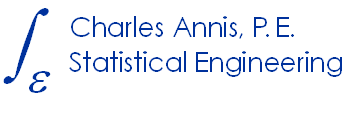Coriolis Statistics
Statistical Relativity and the Coriolis Effect
The Coriolis Effect is well known to engineers and provides a parable for the relationship between a sample statistic and the population parameter that it estimates.
There is a narration so you may want to turn down your computer’s volume. To see full screen (but with only the original resolution), click on the open square symbol.
At first there may seem little similarity between this well-known Physis 101 demonstration, and the behavior of sample statistics, but the similarities are quite profound.
- The video demonstrates that while the ball’s trajectory is “really” rectilinear (to an observer on the ground), it is obviously curved relative to any measurements made on the revolving merry-go-round.
- As we will show, the behavior of a random variable may “really” be normal (with respect to known population parameters \(\mu \text{ and } \sigma\) (mean and standard deviation), but it is very much different relative to sample statistics \(\bar{X} \text{ and } s\).
Most engineering Monte Carlo studies begin with the model parameters as given. How could it be otherwise?
But in any real situation the model parameters are not known. In fact, even the model itself is not known. Normal? lognormal? Weibull? Beta? or mixtures of these? And these are continuous densities. What of the discrete densities? Or non-standard densities? Even when the model can be taken as known, its parameters (e.g. \(\mu \text{ and } \sigma\) for a Normal model) still must be estimated from the data.
Since the true values of \(\mu \text{ and } \sigma\) are not known, engineers “learned” to compute \(\bar{X} \text{ and } s\) and then substitute them for \(\mu \text{ and } \sigma\).
Unfortunately, this isn’t what we were taught, even if it does appear to be what we “learned.” So what’s wrong with this picture?
In practice, statistical model parameters, like \(\mu \text{ and } \sigma\), are not usually known, and must be inferred from \(\bar{X} \text{ and } s\). Random samples from a Normal density often display very non-Normal behavior, especially when the sample size is small (\(n \lt 30\)), tempting the use of another model (e.g. Weibull) which may fit the current sample better, but be less effective in predicting future observations.
Credits:
Among several other places, I found this video at the PBS website, referenced as part of the University of Illinois WW2010 Project where is is found as http://ww2010.atmos.uiuc.edu/(Gh)/guides/mtr/fw/crls.rxml

